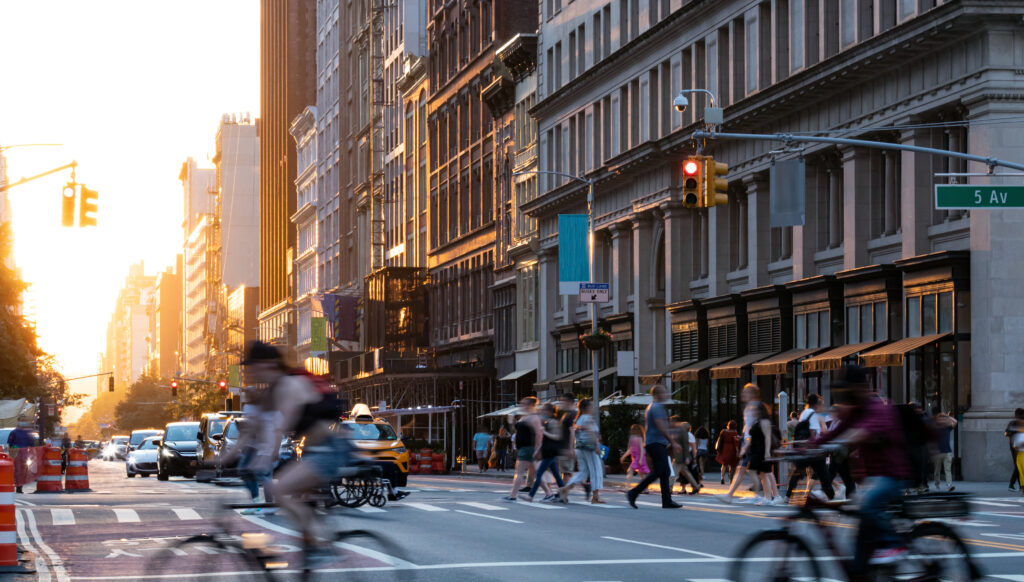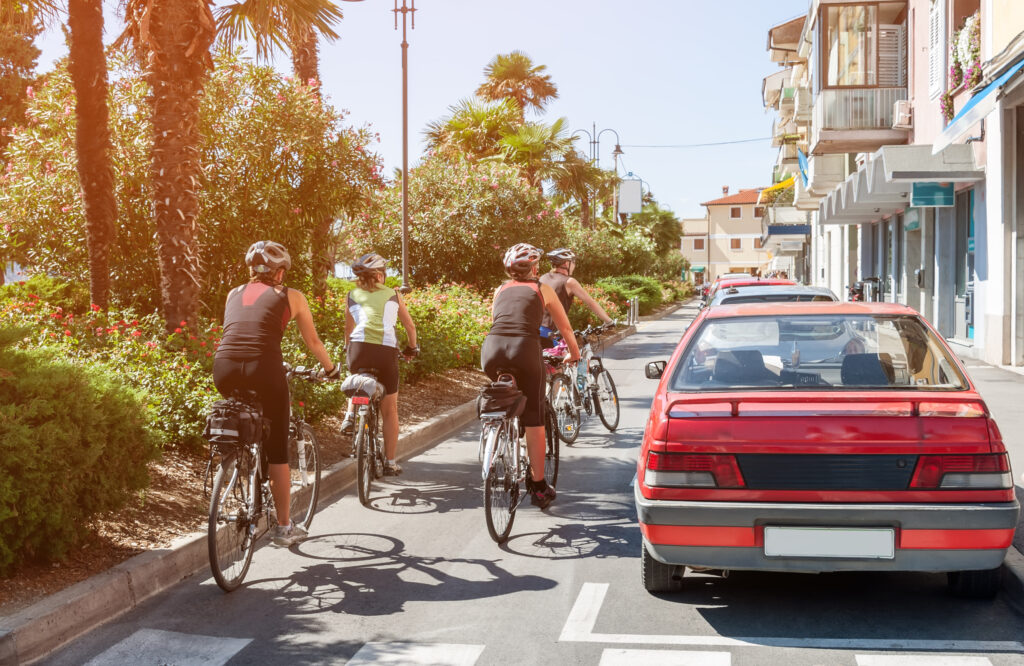Many myths about road cyclists create misunderstandings and safety issues. This article debunks the most common myths, providing clear explanations for better road sharing. Whether you’re a cyclist or a driver, this insight will improve your understanding.
Key Takeaways
Cyclists must follow the same traffic laws as motorists, including the ability to occupy the full lane when necessary for safety.
While a minority of cyclists may disobey traffic rules, many adhere to them, and cyclists contribute to road maintenance through various taxes.
Advancements like pedal assist bikes make long commutes feasible for cyclists, and properly designed bike lanes enhance safety in busy areas.
Myth: Road Cyclists Should Always Stay to the Right

One of the most common cycling myths is that road cyclists should always stay to the right, hugging the curb as closely as possible. This misconception stems from a misunderstanding of traffic laws and the practicalities of safer riding. Bicycles are often classified as vehicles, so cyclists must adhere to the same traffic laws as motorists.
Cyclists must position themselves according to their speed and the traffic conditions. This often means riding to the right, but not always. For instance, if the lane is too narrow for a bicycle and a car to share side by side safely, cyclists are allowed to take up the entire lane for their safety. Moreover, at intersections, cyclists must yield if they do not have the right of way, just as motor vehicles do.
When changing lanes, cyclists are required to yield to traffic in the traffic lane and car lanes they intend to occupy. This ensures that they integrate smoothly and safely into the flow of traffic. Understanding these rules helps both cyclists and motorists navigate roadways safely and efficiently, respecting each other’s rights and responsibilities.
Myth: All Road Cyclists Run Red Lights
A widespread myth suggests that all road cyclists run red lights, flagrantly disregarding traffic signals. This belief overlooks the responsible behavior of many cyclists who adhere to traffic rules just like other road users. This misconception likely arises from the visibility of the few who break the rules, casting a shadow over the entire cycling community.
Most cyclists prioritize road safety and visibility, often positioning themselves in the middle of the street rather than sticking to bike lanes to avoid being unseen by motorists. This strategic positioning can sometimes be misinterpreted as rule-breaking when, in fact, it is a safety measure.
Responsible cycling behavior is common, and many cyclists work hard to follow traffic laws and contribute to a safer road environment for everyone.
Myth: Road Cyclists Don’t Pay Their Fair Share
A common myth is that road cyclists do not pay their fair share for using public roads. This misconception ignores the fact that roadways are primarily funded by general taxation, not just user fees. In fact, only about 8% of roadway funding comes from user fees like gas taxes and registration fees, with the remaining 92% coming from general funds.
Cyclists contribute to these general funds through various taxes, including property tax and sales tax. This means that even those who do not own a car still support the maintenance and construction of roads through state and local funding. Additionally, investments in bicycle infrastructure tend to create more local jobs compared to traditional road projects, providing both economic and social benefits.
Moreover, active transportation options like cycling lead to broader social benefits, such as enhanced community interaction and reduced crime rates. By understanding these contributions, it becomes clear that cyclists do indeed pay their fair share and bring additional value to the community.
Myth: Cycling on Busy Roads Is Too Dangerous
The belief that cycling on busy roads is too dangerous deters many potential cyclists. However, properly designed bike lanes and protected bicycle lane paths significantly reduce the risk of accidents. Research shows that cyclist safety improves with the increase in adequate infrastructure and road infrastructure in urban areas.

High-traffic locations with well-marked bike lanes are associated with lower injury rates compared to roads without dedicated cycling space. For instance, the installation of separated cycle tracks in roundabouts can lead to a substantial decrease in injury rates among cyclists. These infrastructure improvements make cycling a safer and more viable option, even in busy urban areas.
Cyclists need to be aware of their surroundings and use strategies like signaling their intentions and merging into traffic lanes cautiously when necessary for safety. By adopting these practices, cyclists can navigate busy roads more safely and confidently.
Myth: You Need Expensive Gear to Ride Safely
Many believe that to ride safely, cyclists need to invest in expensive gear. This myth can discourage new cyclists from taking up the activity. In reality, safety can be achieved with budget-friendly options without compromising on protection or comfort. Quality safety equipment, such as helmets and lights, can be found at affordable prices.
Reflective materials and lights are essential for visibility, and there are plenty of cost-effective options available. Cycling gloves, which provide protection and comfort, are another example of budget-friendly gear that can enhance the riding experience.
Believing that only high-end gear ensures safety is a common cycling myth that needs to be debunked.
Myth: Only Athletes Can Be Road Cyclists
The idea that only elite athletes can be road cyclists is another myth that needs debunking. Cycling is an inclusive activity that welcomes people of all shapes, sizes, and fitness levels. Many everyday people enjoy cycling, not just elite athletes. There is no specific body type required to enjoy cycling; anyone can participate and benefit from this healthy activity.
Cycling is increasingly recognized as a fitness activity suitable for individuals from all walks of life. Consistent riding can help build cycling fitness, and pedal assist bikes make longer trips feasible and enjoyable for many. This versatility shows that cycling can cater to individual preferences and needs, making it accessible to a wide audience.
Myth: Road Cyclists Are a Menace to Other Road Users

The idea that road cyclists and bicycle riders are a menace to other road users is largely unfounded. Statistics show that cyclists are involved in far fewer pedestrian fatalities compared to motor vehicles. The visibility of cyclists breaking rules often exaggerates their perceived danger, while similar behavior by motorists goes less noticed.
Drivers may view cyclists as an ‘out group’, generalizing the actions of a few to the entire community. From 2007 to 2016, no pedestrians were killed by cyclists jumping red lights in Britain, while motor vehicles caused several pedestrian fatalities each year through similar behavior. This highlights that cyclists are not the menace they are often portrayed to be.
Cyclists riding have the same rights as motor vehicles on the road and are an essential part of the transport mix. Respecting these rights can help reduce tensions and promote safer road sharing.
Myth: Bicycles Are Slower and Cause Traffic Jams
Believing that bicycles are slower and cause traffic jams overlooks the efficiency of cycling. A bike and rider take up far less road space compared to a car or bus, which can help reduce congestion, especially in urban settings. Encouraging cycling as a primary mode of transport can significantly enhance overall traffic flow and sustainability in cities.
By taking up less space and being more efficient, bicycles can improve traffic conditions rather than hinder them. This understanding can encourage more people to consider cycling as a viable transportation option.
Myth: Cyclists Don’t Need to Follow Traffic Rules
The belief that cyclists do not need to follow traffic rules is far from the truth. Data suggests that the majority of cyclists obey traffic signals, with only a small percentage found to jump red lights in studies conducted in places like London. Adhering to traffic signals and rules can significantly reduce the risk of accidents between cyclists and motor vehicles.
In some regions, it is legal for cyclists to run red lights in specific situations, such as when they cannot trigger the traffic light after stopping. The ‘Idaho Stop’ law, which allows cyclists to treat stop signs as yield signs, can enhance safety by reducing collisions at intersections.
Cyclists ride predictably and signal their intentions, improving safety for everyone on the road.
Myth: Bicycling is Ineffective for Long Commutes
Believing that bicycling is ineffective for long commutes is outdated due to advancements in technology. Pedal assist bikes and e-bikes allow cyclists to cover longer distances with reduced physical strain, making them suitable for commuting. These innovations significantly decrease the time and effort needed for commuting compared to traditional bicycles.
Many cyclists find long commutes feasible and efficient thanks to these advancements. Bicycling can be a practical and enjoyable mode of transportation for longer distances, offering both health benefits and convenience.
Summary
Throughout this blog post, we’ve debunked some of the most common myths about road cycling. From understanding the legalities of cycling on the road to recognizing the contributions cyclists make to road funding, it’s clear that many misconceptions need to be corrected. Cycling is a safer, inclusive, and efficient mode of transportation that benefits individuals and communities alike.
By addressing these myths and providing factual information, we hope to encourage more people to take up cycling and to foster a more respectful and informed relationship between cyclists and other road users. Embracing cycling can lead to safer, healthier, and more sustainable urban environments.
Frequently Asked Questions
Do cyclists have to follow the same traffic laws as motorists?
Yes, cyclists must follow the same traffic laws as motorists, including obeying traffic signals and yielding at intersections. This ensures the safety and order of traffic for all road users.
Why do some cyclists ride in the middle of the street instead of bike lanes?
Cyclists may ride in the middle of the street for improved visibility and safety, as this position helps them be seen by motorists and reduces the risk of accidents. It’s a strategic choice to enhance their protection on the road.
How do cyclists contribute to road maintenance if they don't pay gas taxes?
Cyclists contribute to road maintenance via general taxation, such as property and sales taxes, which support the infrastructure they use. Thus, their presence on the road is supported by broader funding mechanisms.
Are bicycles really safer on busy roads with dedicated infrastructure?
Yes, research shows that dedicated cycling infrastructure, such as protected bike lanes, significantly enhances cyclist safety on busy roads. Prioritizing such facilities can lead to safer riding environments for cyclists.
Can pedal assist bikes make long commutes feasible?
Yes, pedal assist bikes make long commutes feasible by reducing physical strain and effort, allowing for a more efficient and enjoyable ride.


